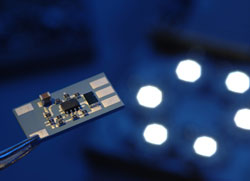Magnetic Ceramics Films for Smaller Transformers

This type of circuit adapts the voltage, current, and frequency to the electrical consumer, for instance, a lamp. In order to save space, as many components as possible — resistors and coils, for example — are incorporated into the individual layers of ceramic printed circuit boards, thus creating metallic surfaces or conductors.
Until now, however, it has been difficult to embed magnetic cores, like those used for transformers, into ceramics. The new film solves this problem, thus saving space in car headlights that use discharge lamps, for example. Such headlights are fitted with ballasts to create the high voltage needed for generating light. The new system would make it possible to incorporate the ballast directly into the lamp in the future.
Transformers change the current and voltage of alternating current. They consist of a closed magnetic core with two windings. If the component is incorporated into a printed circuit board, the windings are created in two of the board’s layers and the magnetic core is installed into a drilled opening. Doing this in ceramic printed circuit boards is a very complicated and expensive process because the magnets and ceramics expand differently when heated, making separate sintering or firing procedures necessary.
However, the researchers at Siemens have now developed a magnetic ceramic film which is laid on the transformer winding between the printed circuit board’s individual layers, where it takes over the function of the magnetic core. The ferrite film is only a few tenths of a millimeter thick and can be fired together with the ceramic circuit board in a single process step at less than 900 degrees Celsius. A transformer embedded in this manner and having an edge length of about 1.5 to two centimeters and a height of 1.5 millimeters transfers an output of 120 watts at a frequency of 2.5 megahertz.
The new, flat high-frequency transformer technology is designed for applications in which space is at a premium and ambient temperatures are high. In addition to being used for lighting and industrial applications, the new film can overcome the difficulty posed by simultaneous inductive transmission of energy and of sensor and control signals between otherwise incompatible printed circuit board technologies for high-performance and control electronics.
Among the beneficiaries of the new film are quick-charging systems for electric cars. Such systems have to handle currents of about 100 amperes while providing power to the communication units linking the charging station with the battery. The German Federal Ministry of Education and Research is helping to fund the film’s development.
Media Contact
More Information:
http://www.siemens.com/researchnewsAll latest news from the category: Materials Sciences
Materials management deals with the research, development, manufacturing and processing of raw and industrial materials. Key aspects here are biological and medical issues, which play an increasingly important role in this field.
innovations-report offers in-depth articles related to the development and application of materials and the structure and properties of new materials.
Newest articles
Humans vs Machines—Who’s Better at Recognizing Speech?
Are humans or machines better at recognizing speech? A new study shows that in noisy conditions, current automatic speech recognition (ASR) systems achieve remarkable accuracy and sometimes even surpass human…

Not Lost in Translation: AI Increases Sign Language Recognition Accuracy
Additional data can help differentiate subtle gestures, hand positions, facial expressions The Complexity of Sign Languages Sign languages have been developed by nations around the world to fit the local…

Breaking the Ice: Glacier Melting Alters Arctic Fjord Ecosystems
The regions of the Arctic are particularly vulnerable to climate change. However, there is a lack of comprehensive scientific information about the environmental changes there. Researchers from the Helmholtz Center…



